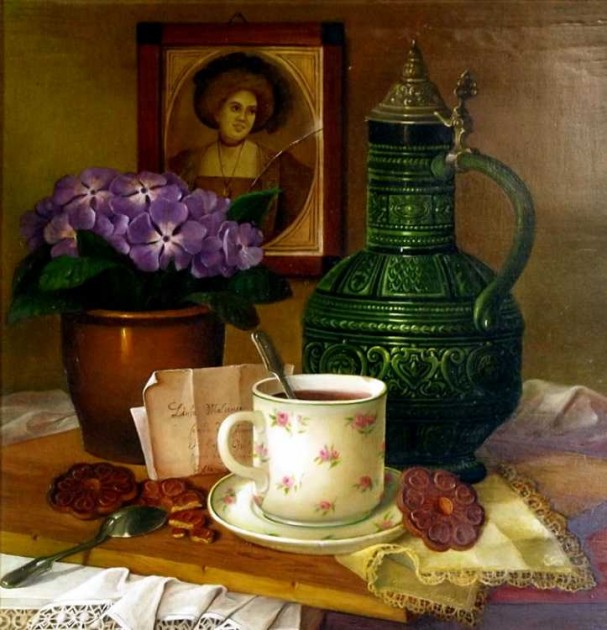
MAJOLICA BEER SERVER – (Artist: Gemälde, Cornelia Raeder – 20. Jh., Fürth).
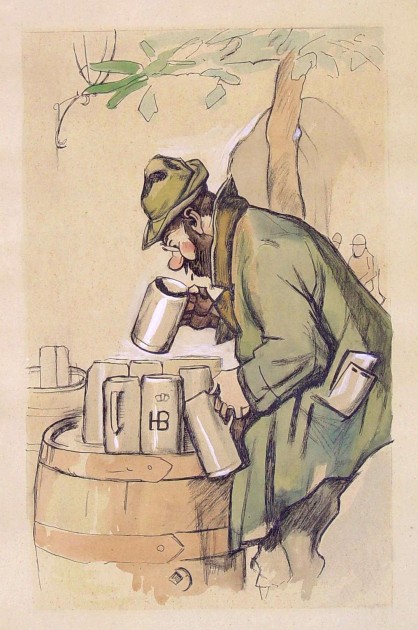
Maas- One liter serving of beer called a “Maas,” typically served in a stoneware beer mug / stein. [Illustrator: “Noagal Zutsla.” Ca. 1930.]
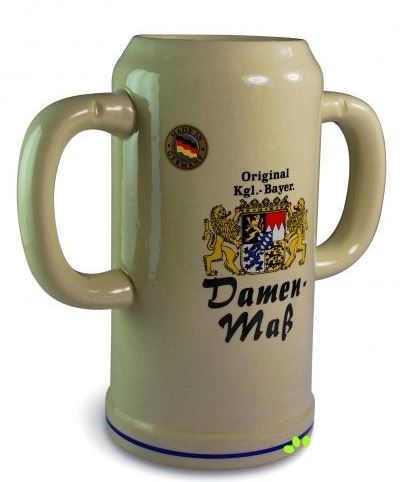
▲ A Newer brewery two handled Maas. Some of the older ones had one full lid split in half , or two overlapping lids.
Mass (cont.)- A Bavarian measure (Old and New standards) In response to a question on another page of this web site, I received this reply from Herr. Weis in Munich (2-2012):
I went through the unanswered question part today, and I can certainly answer the question 9 about the peg at the side of pewter mugs. These are typical for southern German and Austrian pewter vessels, and they are indeed marks for measuring. You can imagine, that somebody paying for a drink in a tavern or sending his kid to the neighbourhood brewery wanted his money’s worth. So most drinking vessels had this peg added by the pewtersmith to indicate the right measure.
Contrary to the modern “Maas” (Maas = measure) of beer at the Oktoberfest which today is one liter, the old Bavarian “mass” was about 1.1 liters, it was abolished in the mid 19th century when all German measures where changed to the metric system. You can actually test it, most vessels will hold one “mass”, 1.1 liters if you fill the up to the peg. Larger or smaller vessels might also have 0.55, 1.65 or 2.2 liters, but it is always multiples of the old Bavarian “Mass”. And, of course, all modern beer glasses do have small indications on the side to show when the right measure of beer has been filled in.
Our many thanks go to Herr. Weis !!
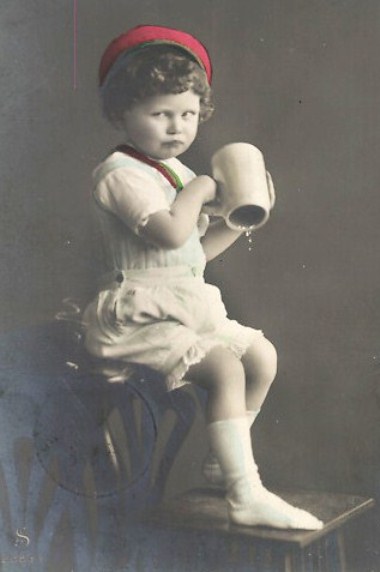
“My Maas is empty and I’m pissed!”
“Made in Germany”, mark (Origin of the) . The term ‘Made in Germany’ came into being thanks to the British Parliament which passed the ‘Merchandise Act’ on August 23rd 1887 in order to protect the British market from German imports. It required that all goods from Germany had to carry an un-removable mark with the wording ‘Made in Germany’. Today we of course know that the whole act backfired because what was originally intended as a branding mark finally became a free trademark and the epitome of a seal of quality or warranty for good value. And of course a few years later – especially after the revision of the US McKinley Tariff Act – manufacturers all over the world started to adapt this form of marking. The ‘Made in .’ prefix by the way never was a requirement of the US rules and regulations or the McKinley Tariff Act regardless of what people claim. McKinley Tariff Act: Origin of the ‘FOREIGN’ marking: On October 1st 1890 the Congress of the United States passed the so-called ‘McKinley Tariff Act’, a law that was introduced by the 25th President, William McKinley. This law not only imposed the highest tariffs that the United States had ever placed on imports it also demanded that regardless of country of origin all items imported to the US had to be marked as such, ‘FOREIGN’. The act was later revised in two steps and while the first allowed the real country of origin to be used, based on the fact that Great Britain had already forced Germany to use ‘Made in Germany’ for their goods. The second change introduced the regulation that only standard English terms and characters were legit after the newly-founded state of Czechoslovakia in 1918 had started to use foreign characters (see ‘Čechoslovakia’ on marks (1918-1920)’). [Steve’s note: All the above information▲per “P M & M”: http://www.porcelainmarksandmore.com/resources/historical.php What a great informational web site! It certainly clears up a lot of misinformation! Following the founding of the two German states in October 1949 the western manufacturers saw themselves confronted with a problem. At that time and under economic/quality aspects the reputation of everything marked ‘Made in Germany’ was very high, on the other hand it was known that the whole system of production in regions influenced by the Soviets was less than adequate. Believing that the split of the two states was no more than a temporary solution and one should hold open a back door, the manufacturers in the Federal Republic of Germany thought it would be a good idea to use ‘Western Germany’ as that was near enough to the old ‘Germany’ but also implied western world orientation and distanced them from the sub-standard Soviet-influenced East German side. The German Democratic Republic countered by starting to use ‘Eastern Germany’ and the ‘name race’ started with all its twists and (partially funny) turns. After the fall of the Wall in November 1989 and the official German reunification on October 3rd 1990 all companies nearly instantly used ‘Made in Germany’ again. The only thing you can be really sure about is that a product marked with any kind of East/West German designator can only have been made sometime between 1950 and 1990. No more, no less. Against what is commonly claimed by various ‘collectors’ and ‘experts’ one should know that some East German companies at first continued to use ‘(Made in) Germany’ even during their time in the German Democratic Republic; some even up until 1972. The interest of some sellers in keeping these facts low is obvious as many people want to sell their items off as been made before 1949 (and hence being more desireable) even if they were made much later. Now as for roughly pre-dating all these items, two guidelines apply: [1] A first placement for an item of a single manufacturer can be found by taking into mind the general mark development over time, for example any given western manufacturer used a ‘W.-Germany’ mark later than a ‘Made in West Germany’ mark. Also remember that the prefix ‘Made in’ as part of the mark was at that time often seen optional so its use can change according to free space on the item, mark design or other preferences. All that can be boiled down to the following short and painless list, evolving over time from left to right:
- (Made in) Western Germany = (Made in) West Germany = (Made in) W.-Germany
- (Made in) Eastern Germany = (Made in) East Germany = (Made in) German Democratic Republic = (Made in) GDR
[2] Dating items is only possible when one knows the marking procedures of the specific company as each of them had their own internal timeline. For example some factories used ‘Western Germany’ on some items right up to 1976 while other manufacturers had long dropped that it in favour of ‘West Germany.’
Made up “set” – A set of anything e.g., wine decanters, Swiss wine cans, measures, etc, where most of the component pieces were not made at the same time or place. Shown ▼: A made up set of Bohemian hand painted ruby wine decanters, some with gold trim all made at different factories and at different times say between Ca 1830-70 but all looking generally alike. [FWTD]
or 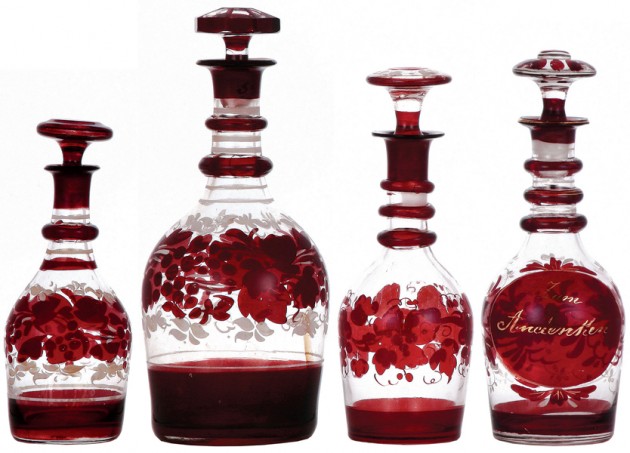
need photo of maders mug missing
Mader’s – A famous German Restaurant located in Milwaukee. .5 liter Westerwald made stein. Ca. 1910 – 1920. A little history from Mader’s web site. Check out what a beer cost then. (http://www.madersrestaurant.com/about-history.html ) Mader’s has been voted the most famous German restaurant in North America. Some years ago, in 1902 to be exact, things weren’t quite the same. An ambitious young German immigrant, Charles Mader, poured his life savings into a speculative venture: he purchased a small building on 233 W. Water Street (now Plankington Avenue) and hung out his sign. “The Comfort,” it read, was comfortable, with it’s “soft” wooden chairs and Oaken tables. Today’s $3,000,000 collection of Medieval Germanic weaponry hadn’t arrived, but you could find a few dozen wall pegs on which to hang coats. Young Mader only served the best of food and drink in his Milwaukee restaurant, so he felt warranted in charging well for his fare. Dinner, including tip and beverage was 20 cents and big steins of “Cream City” beer were 3 cents each, two for a nickel. If you spent 5 cents on beer your lunch was free.
▼ ▼ King John signing the “Magna Carta.” [From Wikipedia, the free encyclopedia.]
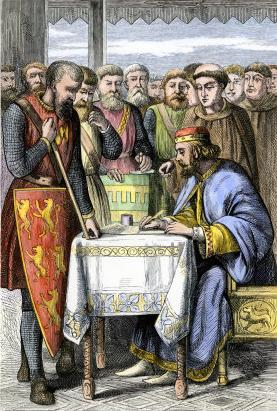
Magna Carta Standard – A provision in the Magna Carta that there should be a standard measure for ale and wine. (England -1215.) This established the basis for future English inn inspectors to assure vessels were of proper sizes. The liter/ capacity marks on German steins are similar, but it has not be proven that this is anything more than a custom or an institution started by local brewers to make certain their customers were happy with the amount placed in their stein.
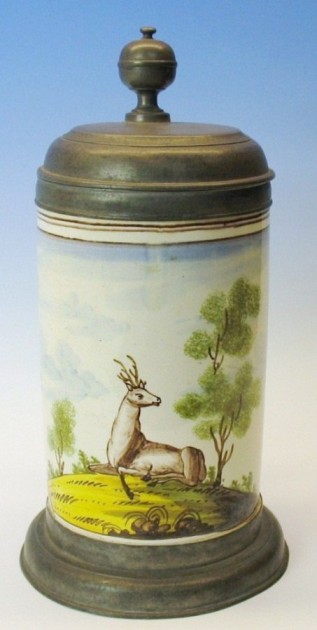
Magdeburg, 1754-1785 – City or town of major fayence stein production. Shown ▲: One of the two types of the general category of Fayence steins produced in this city [FWTD] . See Bill Hamer’s article this site: http://www.steveonsteins.com/guest-writers-articles-identifing-faience-eng-steins-part-6-magdaburg-fayence-germ-beer-steins-by-william-hamer-1
![FAYENCE - MAGDABERG - MINE FOR $400 PLUS SHIP 1-13 [3]](http://www.steveonsteins.com/wp-content/uploads/2013/03/FAYENCE-MAGDABERG-MINE-FOR-400-PLUS-SHIP-1-13-3-384x630.jpg)
Above ▲ a .5 liter Magedaburg stein is done in creamware,which is not real fayence. Most stein collectors could care less.
![FAYENCE - MAGDABERG - MINE FOR $400 PLUS SHIP 1-13 [6]](http://www.steveonsteins.com/wp-content/uploads/2013/03/FAYENCE-MAGDABERG-MINE-FOR-400-PLUS-SHIP-1-13-61-472x630.jpg)
Maine Stein Song –
An Old drinking song. Shown ▼: Copy of original typed formatted song.
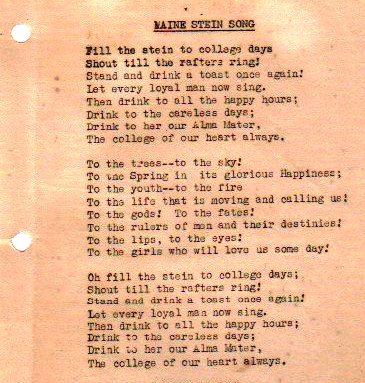
Majolica steins – Very similar to “Habnerware” steins in that they use a lead glaze and not tin. That makes for a much brighter surface. Shown: An Austrian 3 liter stein[!] with classical Greek figures in relief. Circa 1880. [FWTD]. For more on majolica steins, see this page : http://www.steveonsteins.com/?s=majolica&submit.x=6&submit.y=9
Makers of beer steins and tankards – While I have a few listed, please refer to my friend’s web site: Chris Wheeler has done an amazing job in compiling information on most all makers of steins and tankards in Europe. And if your WANTED information is not listed, Chris will be more than wiling to help you out with any info he might have. Go to: http://www.steinmarks.co.uk/pages/pv.asp?p=stein1
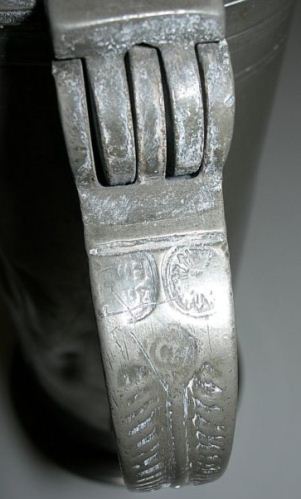
Maker’s Mark – [1] The maker’s touch-mark that acknowledges responsibility for his work, bearing initials or name. A term mostly used with metal steins. In English-speaking countries, on silver it is called a Hallmark. [2] Also a damn good Southern [USA] Bourbon! Shown above ▲: The maker’s mark appears under the two strikes of the city mark on this late 1600’s roerken’s “Herring Bone “handle.
Also see Hallmark and Touchmark.
Mallet flask – A “guild cup” out of pewter in the shape of a brewer’s barrel mallet. These are very rare when original and I’m not saying this one is not as I haven’t seen it. BUT one as shown also sold in Germany in 2010 but without the bird / angel on the top. This one above was or sale in the USA in July 2013 at a SCI Convention auction. Both however are dated 1560. Another is up for sale in Feb 2013 at a DC auction house, but dated 1590. Draw whatever conclusions you wish. Note: in 2015 I bought one of is definitely a replica – however I do not think Weygang made them.
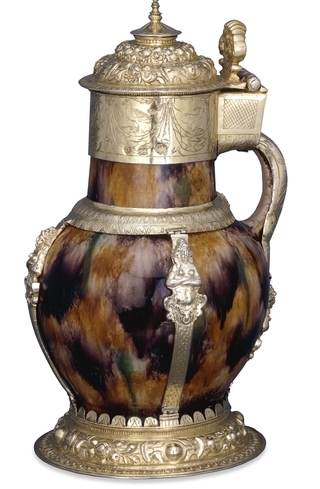
Photo from The British Museum. Sorry, no details available.
Malling jug – Etienne Perlin, a French visitor to London in the 1550s, noted that the English drink beer ‘not in glasses but in earthenware pots with silver handles and covers’. Earthenware remains porous after firing, and earthenware vessels that intended to contain liquid are covered with a glaze. A tankard , one of a number of surviving mounted tin-glazed earthenware pots of bulbous form, with a mottled glaze in brown, blue and purple. It was used in the church at West Malling, Kent until sold in 1903, and consequently all tankards of this type with English mounts dating from the sixteenth century are known as ‘Malling jugs’. The actual origin of the ‘Malling jugs’ has been something of a puzzle. However, as a result of recent archaeological discoveries and current scientific analysis, it is now thought that these jugs were made in the Low Countries (modern-day Holland, Belgium and northern France and Germany) for the London market. Trade between the Low Countries and the southern and eastern counties of England was especially vigorous. The strapwork, figures and foliate ornamental motifs on the mounts are characteristic of English Tudor silver of the time . See also “Tiger-ware” in this site’s Compendium.
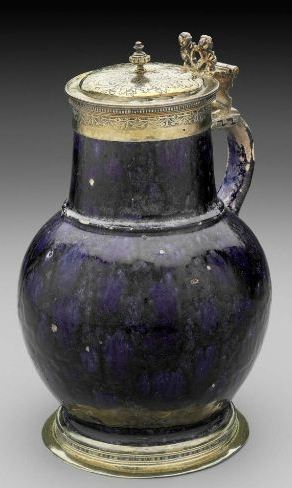
▲ ▲Another malling Jug: tin-glazed earthenware with silver-gilt mounts. Mounts = English (London) 1550–51. Mark = Crowned cross moline. H. 18.1 cm (7 1/8 in.); Diameter (of base) 9.9 cm (3 7/8 in.); W. 11.9 cm (4 11/16 in.) [Comps of Museum of Fine Arts, Boston.]
Man and woman, sitting on rocks – Jacquot and Jacqueline. Fayence or Majolica Character steins, usually used as beer / wine servers. Made in the Netherlands, the modern Belgium area and France. Some of the older ones are quite sizable (and expensive when found. Those shown below ▼ are not very old. They are referred to as “Jacquot and Jacqueline.” and not as one junior USA stein auctioneer called them in 2015 =”A Chinese Couple”
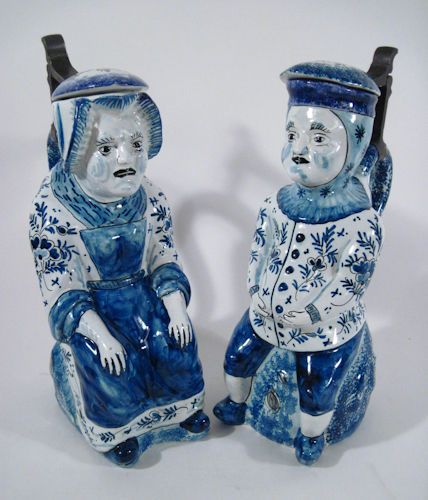
Jacqueline. and Jacquot newer copies of 1600’s Dutch pieces.
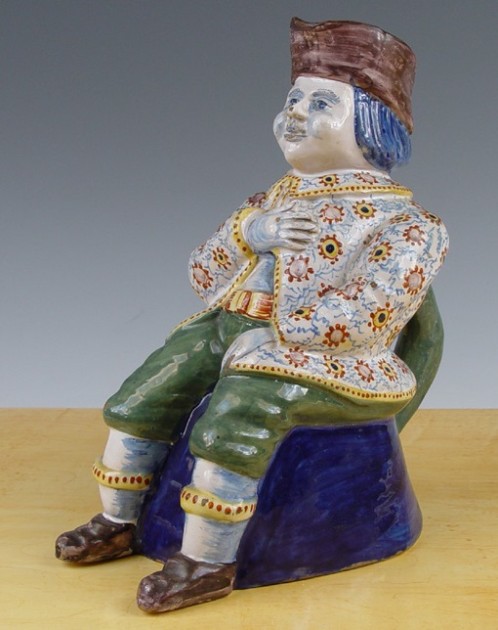
▲ ▲ A different style of Jacquot. He is un-lidded which is unusual, but original but Ca. . early to mid 1900’s
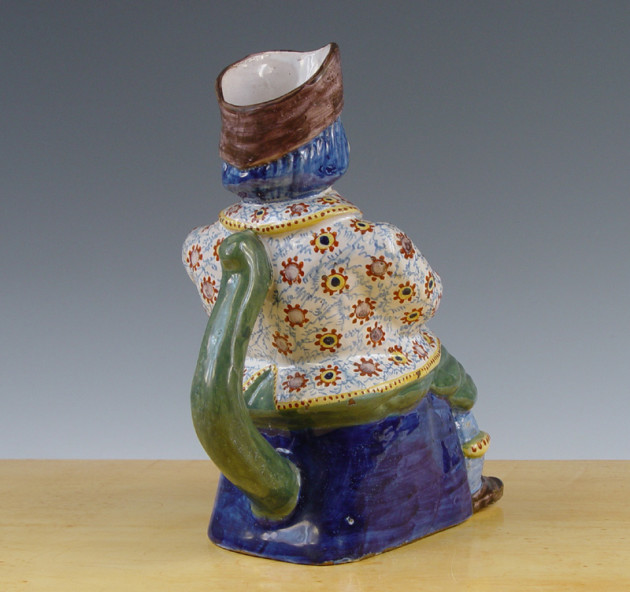
(Jacquot) shown two above ▲ ▲and a woman (Jacqueline on a dirt mound (or a rock.) Shown just above ▲: Jacqueline, This one made in Lille, faience. Origin of the originals was northern France, or Belgium. This is a copy of the earlier 1700’s version, but Circa late 1800’s. See “Jacquot and Jacqueline” in this compendium for more photos, a couple
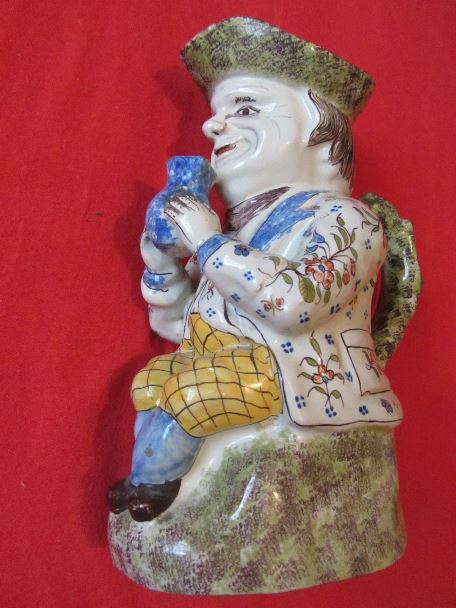
This version from around Rouen France in the 1800’s was obviously influenced by the British “Toby jug” although the man is still sitting on a rock and not a chair that almost all
are on. See chair example below.
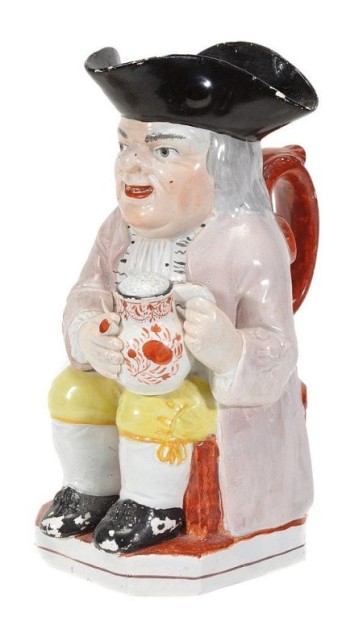
Staffordshire pearlware Toby jug. 1800’s – Sitting on a chair — much more refined [English of course!]; compare with just above.
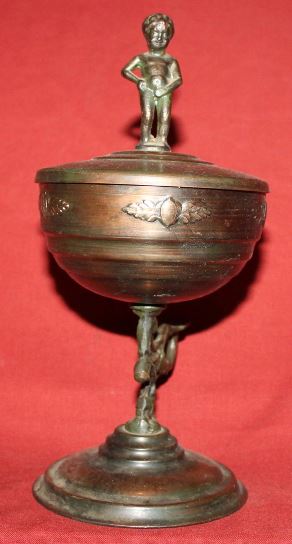
Manneken Pis – A small but famous statue of a little boy peeing located In Brussels. Lots of souvenirs including beer steins produced show this little guy taking a wiz. Shown a molded
cup with cover . 8,8 inches , Made in Brusslels . Not too well done cast finial of the boy.
![MANNING BOWMAN, COPPER AND PEWTER EARLY 1900]S](http://www.steveonsteins.com/wp-content/uploads/2011/02/MANNING-BOWMAN-COPPER-AND-PEWTER-EARLY-1900S-490x630.jpg)
Manning Bowman – A USA manufacturer of American College steins Shown: An early 1900’s (non cleaned) copper and pewter version with the typical “bent back” USA thumblift popular at the time. For more info on this firm, see: http://www.steinmarks.co.uk/pages/pv.asp?p=stein679
Mantling – That portion of a “Coat of Arms” that represents the linen that hung off the back of the helm to protect the Crusader’s neck from the sun. The mantling is usually composed of the major colors in the arms. Shown: A porcelain insert with the mantling being the fancy cloth of blue, gold and dark red (the red is not part of the Arms!) on both sides of the shield.
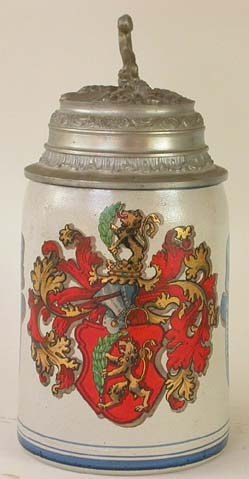
▲ ▲Another excellent example of “mantling” on a half liter stoneware stein Ca. 1890
Manufacturers of steins and tankards – Please refer to my friend’s web site: Chris Wheeler has done an amazing job in compiling information on most all makers of steins and tankards in Europe. And if your info is not listed Chris will be more than wiling to help you out with any info he might have. Go to:
http://www.steinmarks.co.uk/pages/pv.asp?p=stein1
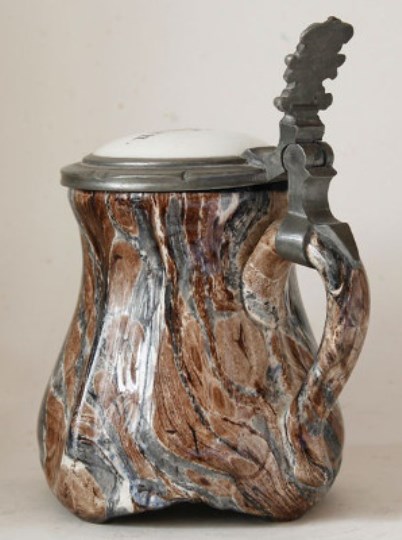
MARBLELIZED – Marble Glaze Majolica Beer Stein by Dorfner and Co. c.1860s
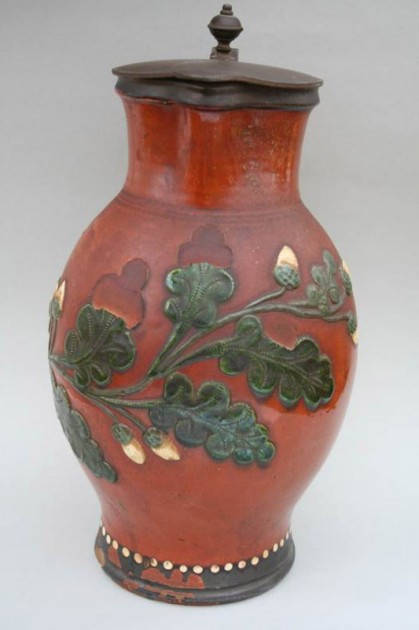
Marberg – A little known German pottery factory. Shown ▲: Applied relief server, late 1700- early 1800’s.
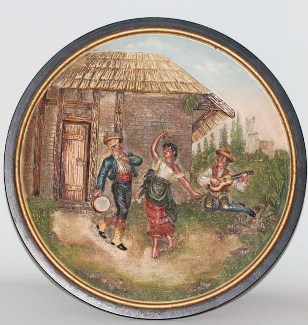
Maresch. J. M. – German maker of a few LARGE dark brown pottery mugs. Mostly known for his heavy relief wall plaques. Shown: One of his relief pottery plaques, 15.2 inch diameter. See: http://www.steinmarks.co.uk/pages/pv.asp?p=stein1
Marks on beer steins and tankards –[1] The basic marks. See Walt’s article: http://www.steincollectors.org/library/articles/marks/marks.htm [2] Please refer to my friend’s web site. Chris Wheeler has done an amazing job in compiling information on most all makers of steins and tankards in Europe and the world If the mark sought is not listed, Chris will be more than willing to help you out with any info he might have. Go to http://www.steinmarks.co.uk/pages/pv.asp?p=stein1
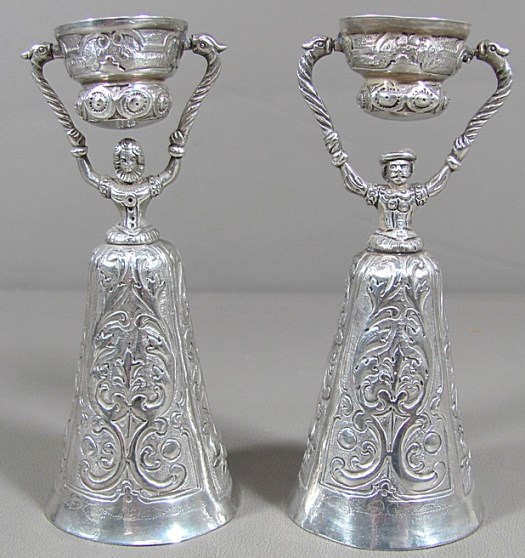
A pair of cheaply made Hanau .800 silver wedding cups. But having the matching man and woman is a nice treat for a Wedding cup collector.
Marriage cup – See: “Wedding Cup” in this site’s Compendium.
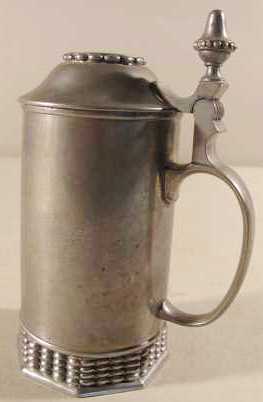
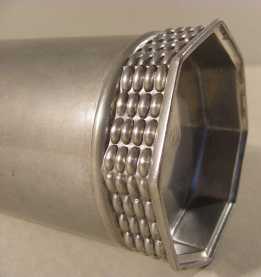
Married steins (not marriage steins), vessels – Steins / drinking which have pieces added to them from another source, and mostly at a later date. This includes those items such as this pewter piece just above which has a somewhat older body form that the pewter-smith decides to “jazz’ up to fit the art deco style. There are two types of “married” steins. [1] Those done by the maker – as the three pewter pieces shown here, 1 above , 2 below. – and [2] the type married to make one piece out of unrelated two parts and deceive the buyer as noted below. Also, as below where one piece from another mold was added to the original body, either by the maker at inception, or later by an owner.
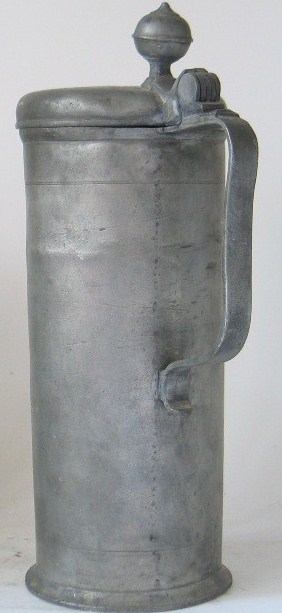
. 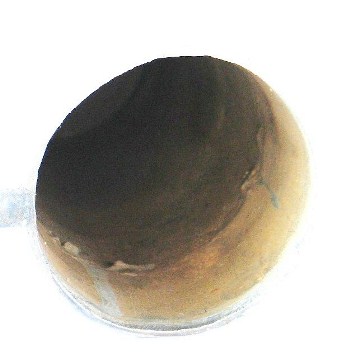

A large piece was “married” to the top of the original molded pewter body to make the taller more popular style of the time. Why it was never finished off inside or outside. I don’t know. Perhaps an apprentice’s learning piece trying to become a “journeyman”? I bought it as I had never seen that type of work before. Holland = Friesland, Ca. 1740 -70. [FWTD]
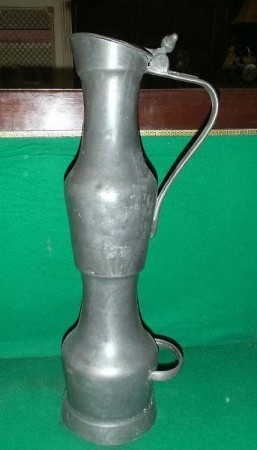
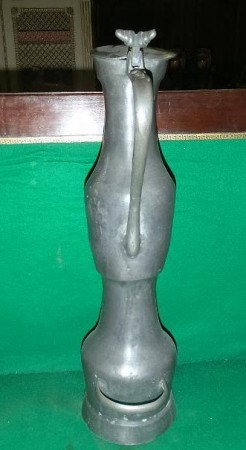
▲ ▲A fantastic and original “married” piece, made out of two bodies; now an extra large French pewter wine server with two handles to use when serving wine at a big party!
Below, two examples of the type married to make one new piece out of unrelated two parts and deceive the buyer. Look at both lower handle attachments; these two ▼ ▼ should be self explanatory!!
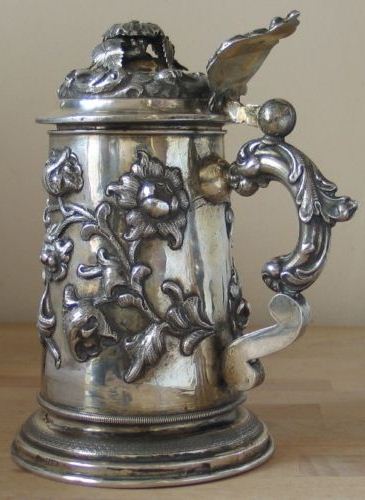
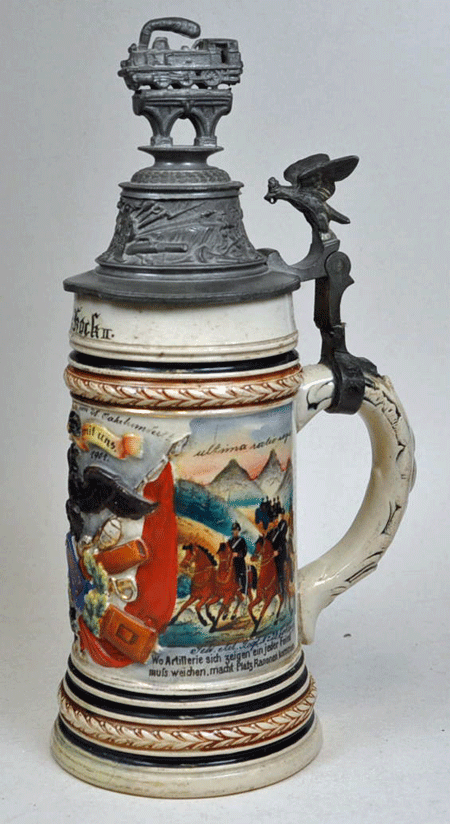 Also an Eisenbahn (Railroad) Reservist’s lid, soldered on at the strap to a different type of military unit = Artillery stein. This was and still is a very common practice. “Married” Reservist steins are probably met with more ofter than any other group of steins!! (see just below.)
Also an Eisenbahn (Railroad) Reservist’s lid, soldered on at the strap to a different type of military unit = Artillery stein. This was and still is a very common practice. “Married” Reservist steins are probably met with more ofter than any other group of steins!! (see just below.)
. 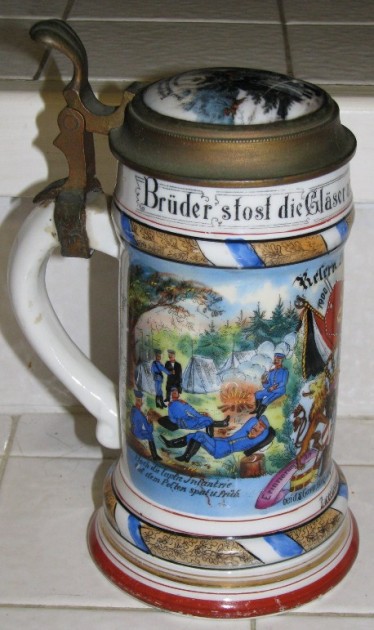
▲ ▲Another example of a reservist steins being married. This one with a lid (shown below) that has nothing to do with the stein body. The strap repair is obvious once you look for it.
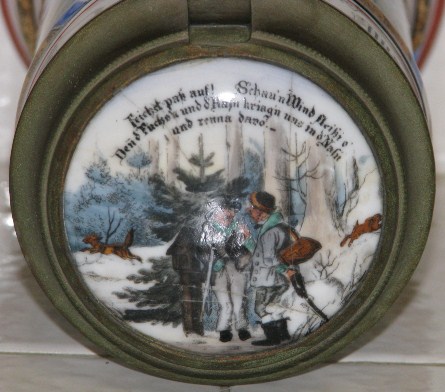
A completely unrelated lid added to this body ~ showing hunters and nothing military.
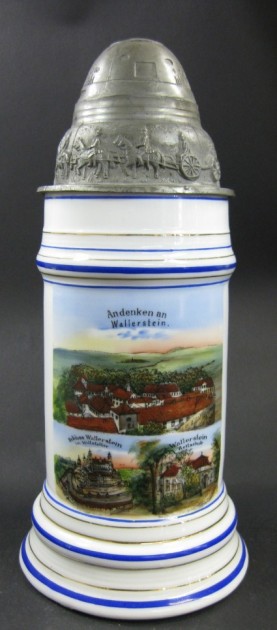
▲ ▲ One that should be obvious to all but the very beginning collector. A reservist’s pewter artillery shell lid has been added to a porcelain souvenir stein from a town. No relationship at all between the two pieces.
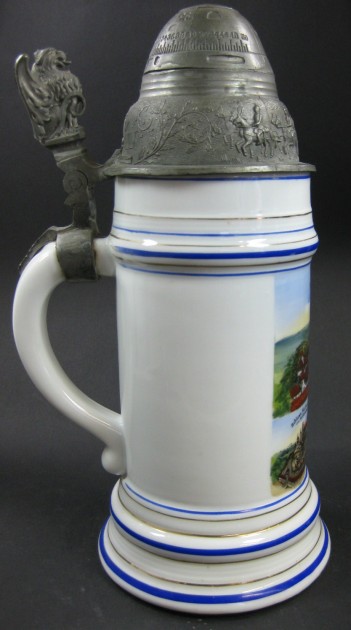

A different type of a “married” piece. One done at the factory. A late 1800’s, James Yates (England) pewter pint tankard that has been turned into a tea pot / liquid server by adding a spout to the body. See the heat discoloration color of the spout right at the body!
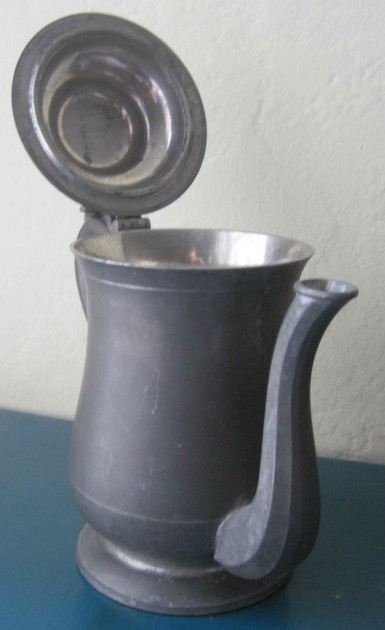
A second one with the soldered seam not as evident.
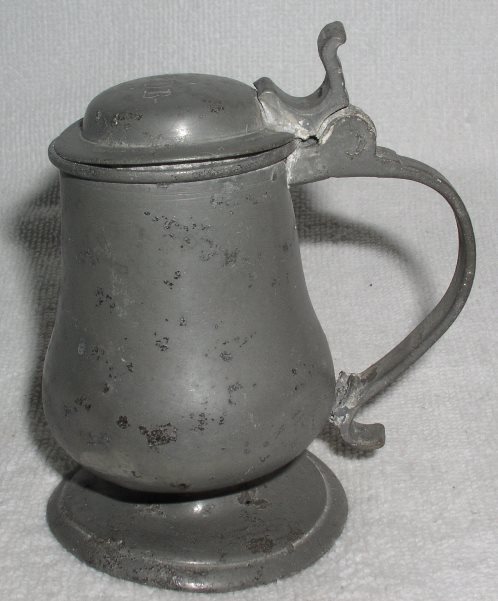
So logic would say the=at the opposite of married would be unmarried, (or divorced) where something was taken away from the piece to change it. Below ▼is such an example ~ this photo sent to me by a fellow stein collector. It is a very old and well used small pewter tankard that I think probably an inn-keeper modified by taking a piece out of the side to change it into a mustard pot for his inn’s guests as it saved him the cost of buying a new one.
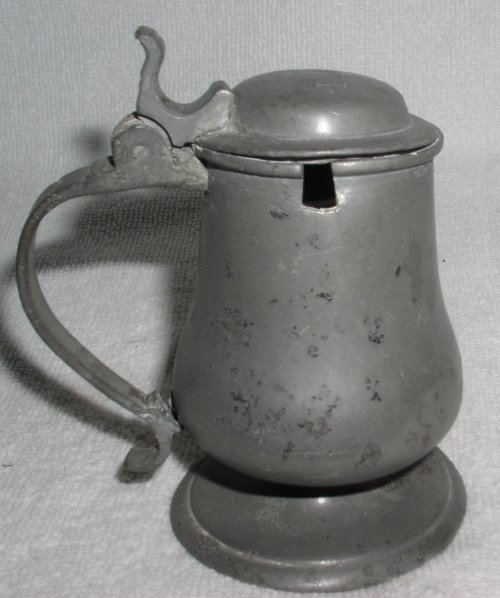
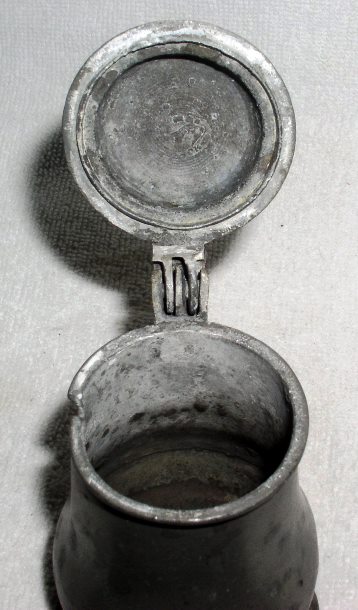
Martele — The French term for “hammered,” used to describe the decorative effect of the honeycomb-patterned facets left on an object by the planishing hammer. This surface was favored in the second half of the nineteenth and early part of the twentieth centuries by silversmiths who wanted to emphasize the impression of hand-work.
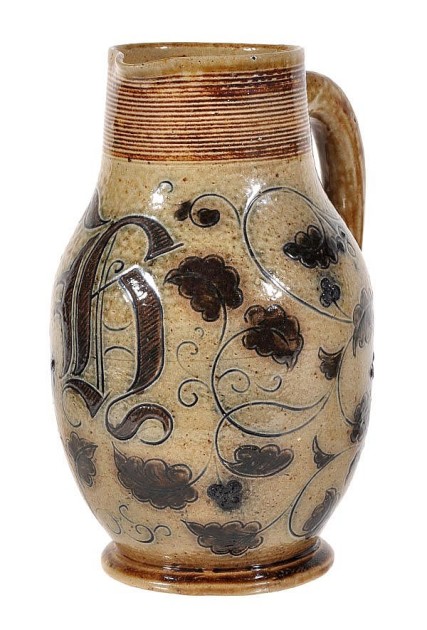
A stoneware jug by the Martin Brothers reminiscent of Royal Doulton in design. A not so famous piece. .
Martin Brothers Pottery – The Martin Brothers were pottery manufacturers in London who are considered to represent the transition from decorative Victorian ceramics to twentieth century studio pottery in England. The four brothers (Wallace, Walter, Charles and Edwin) produced a distinctive type of stoneware pottery from the 1870s through to the First World War, with a little work being produced through to 1923 when their pottery closed. (Wikipedia) The Martin Brothers became famous for their eccentric, grotesquely modeled “Wally Birds” and their wheel-thrown and sculpted face ale jugs and mugs and some Gothic stoneware vases. A fore-runner to the recent character mugs made by Mr. Rumph (see Compendium entry)!
. 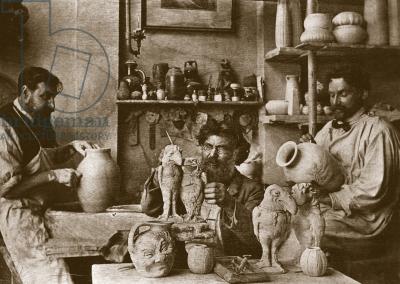
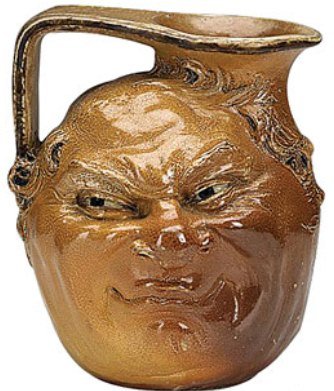
Martin Luther’s stein –
![sos -$ - luther;s tankard - 2 better [q]](http://www.steveonsteins.com/wp-content/uploads/2013/03/sos-luthers-tankard-2-better-q-260x630.jpg)
Shown above ▲: Detail from a newspaper page print of it which is shown just below. It appears it was a large stoneware “schneilenn “from Siegberg (most
likely) . 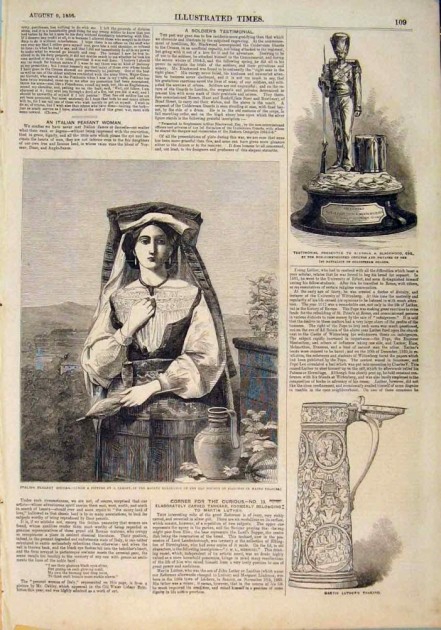
NOTE: here are several copies [not reproductions] made in different materials of the original “out there” in beer stein world;
two are seen below ▼ The first is made of celluloid, a very early plastic,[Stephen Smith Collection]
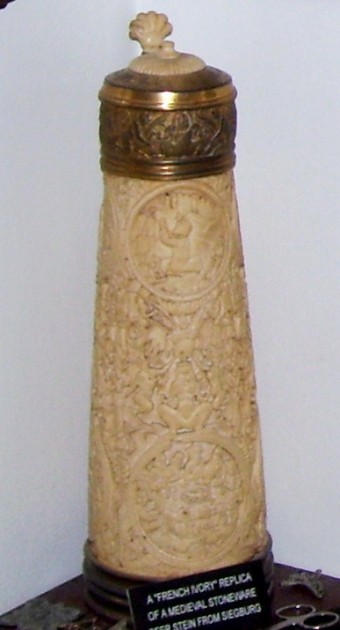
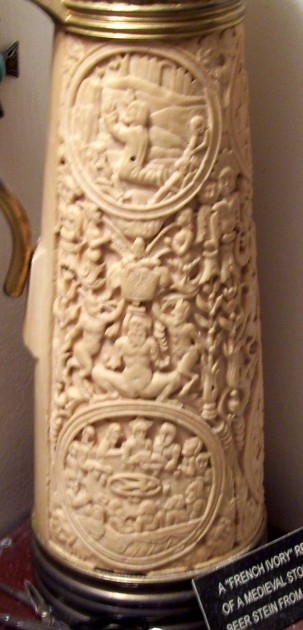
Detail of the total scene which is repeated three times on the stein. I have no idea what that strange creature in the middle , above the “Last Supper”represents. Does any reader know who he is [?] or what he might represent??
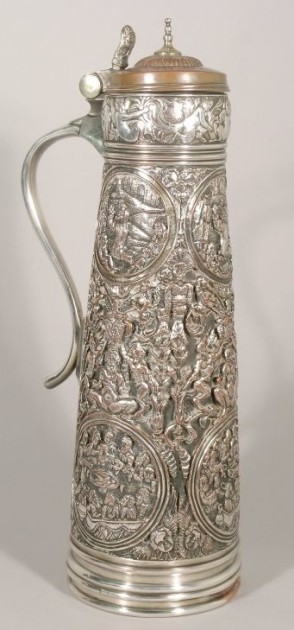
▲ ▲ A silver electro-plated version made by Elkington in England , notice the silver is worn on the body and almost all gone on the lid.
Mary Gregory – Another ‘GLASS’ stein collecting “misnomer.” No such American artist or glass firm for that matter, made steins such as the one shown with the whited frosted enameling. Many of these white enameled pieces were made by Theresienthal and other German glass firms and originally came as drinking sets. Shown below ▼: A master stein depicting “The Trumpeter of Säckingen” (the city is now: Bad Säckingen.) I am over 80% certain these were made by Theresienthal glassworks.
Marzi and Remy – German stein manufactures. Shown above ▲: An art deco stein with modernized putti. See: http://www.steinmarks.co.uk/pages/pv.asp?p=stein1 . 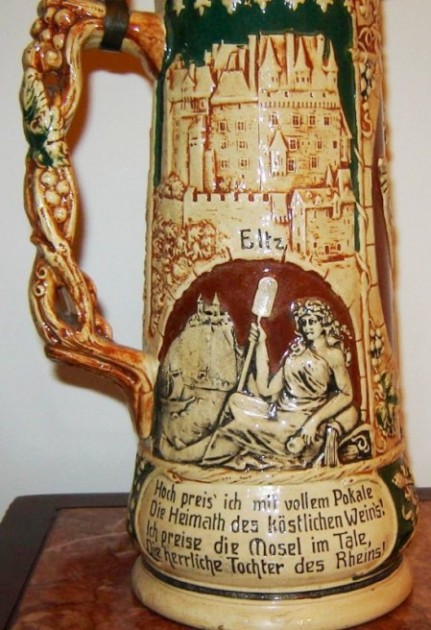
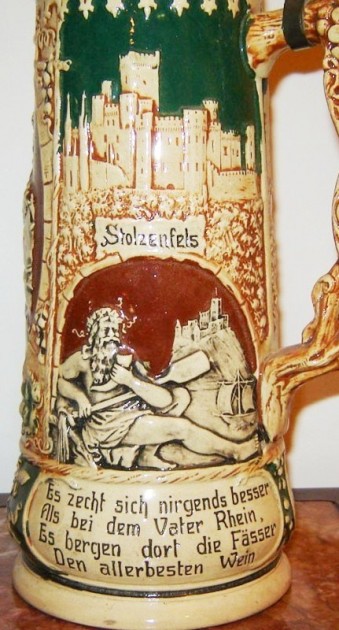 Above: the more typical type of earlier pottery relief design by that firm. They are also one of a few potteries that used the “Twisted vine handle.”
Above: the more typical type of earlier pottery relief design by that firm. They are also one of a few potteries that used the “Twisted vine handle.”
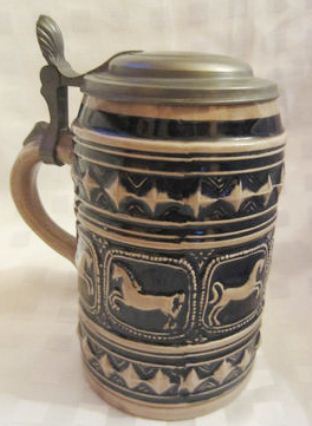 Modern day Westerwald reproduction made by M & R for “König Pilsener.” Dtd. 1979.
Modern day Westerwald reproduction made by M & R for “König Pilsener.” Dtd. 1979. 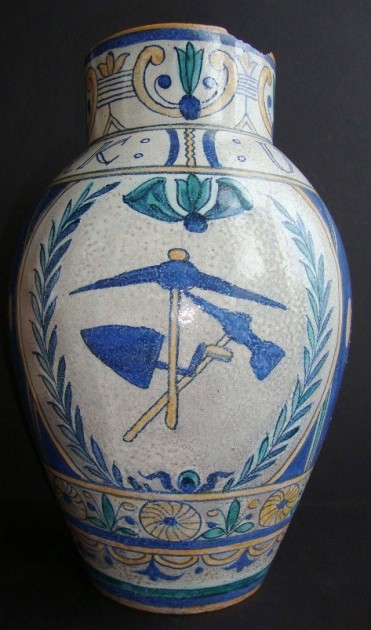 Mason occupational steins – Usually indicated by a trough and other implements of stone / brick working. Shown: a large 11.5 inch tall Masonic beer server from Austria / Italy with Mason’s tools / designs painted on. This is a newer piece, say from the 1970’s on! The color and texture of the pottery gives it away. .
Mason occupational steins – Usually indicated by a trough and other implements of stone / brick working. Shown: a large 11.5 inch tall Masonic beer server from Austria / Italy with Mason’s tools / designs painted on. This is a newer piece, say from the 1970’s on! The color and texture of the pottery gives it away. . 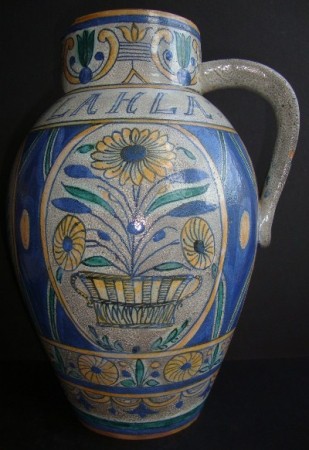 OPPOSITE SIDE
OPPOSITE SIDE 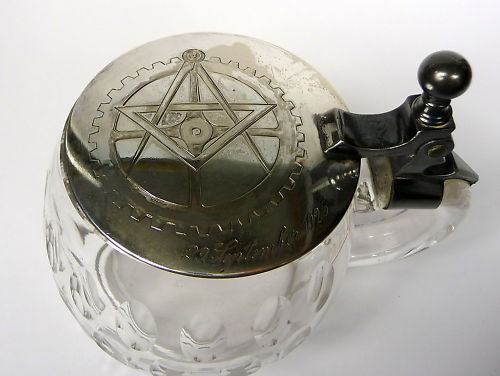 .5 liter Masonic blown and cut glass stein, lid and glass by WMF. Ca. 1910. Masonic steins and other drinking vessels – This could be (and probably will be in the future) a full page on this site, as these steins are plentiful and different, and older ones, say pre-1900, are very collectable.
.5 liter Masonic blown and cut glass stein, lid and glass by WMF. Ca. 1910. Masonic steins and other drinking vessels – This could be (and probably will be in the future) a full page on this site, as these steins are plentiful and different, and older ones, say pre-1900, are very collectable. 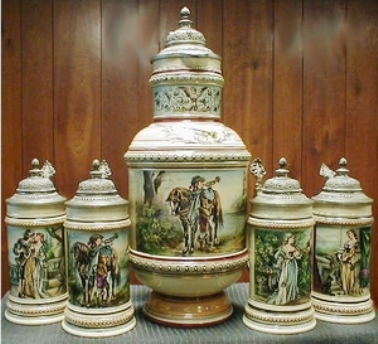 Master stein – A serving stein that come with a set of matching smaller steins, usually 1/2 liters. These sets were usually 6 in number, sometimes 8. Most glass steins came with a serving tray that all the pieces fit on. Shown: A nicely done colored pottery PUG set with a Master stein, with scenes from “The Trumpeter of Sackingen.” A very attractive set. [Stein Center]
Master stein – A serving stein that come with a set of matching smaller steins, usually 1/2 liters. These sets were usually 6 in number, sometimes 8. Most glass steins came with a serving tray that all the pieces fit on. Shown: A nicely done colored pottery PUG set with a Master stein, with scenes from “The Trumpeter of Sackingen.” A very attractive set. [Stein Center] 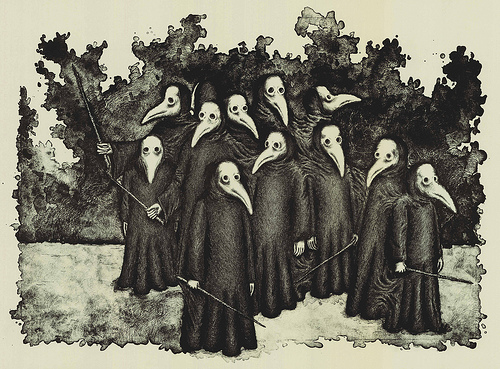 Master Steinologist – Perhaps the most prestigious award offered every year at the SCI (Stein Collector’s International) convention. The award originally was given to someone within the convention’s host chapter, but within a few years it was awarded for writing and giving lectures about all aspects of stein collecting, or helping out SCI in some fantastic way. Now each Master Steinologist is voted on by his / her peers using a system that allows only one vote above the underdog needed to win . When I suggested a much fairer system I was told to “K.I.S.S. = KEEP IT SIMPLE STUPID!” by one of the SCI officers. Oh well, SCI = 52 years of tradition, unhampered by progress! Shown above▲: A meeting of all the recent Master Steinologists at one of the conventions. New SCI Master steinologist Exam. One only need 4 correct out of 10 questions to pass and become one of the elite. 1) How long did the Hundred Years’ War last?
Master Steinologist – Perhaps the most prestigious award offered every year at the SCI (Stein Collector’s International) convention. The award originally was given to someone within the convention’s host chapter, but within a few years it was awarded for writing and giving lectures about all aspects of stein collecting, or helping out SCI in some fantastic way. Now each Master Steinologist is voted on by his / her peers using a system that allows only one vote above the underdog needed to win . When I suggested a much fairer system I was told to “K.I.S.S. = KEEP IT SIMPLE STUPID!” by one of the SCI officers. Oh well, SCI = 52 years of tradition, unhampered by progress! Shown above▲: A meeting of all the recent Master Steinologists at one of the conventions. New SCI Master steinologist Exam. One only need 4 correct out of 10 questions to pass and become one of the elite. 1) How long did the Hundred Years’ War last?
6) The Canary Islands in the Pacific are named after what animal? 7) What was King George VI’s first name? 8) What color is a purple finch? 9) Where are Chinese gooseberries from? 10) What is the color of the black box in a commercial airplane? ,
ANSWERS TO THE QUIZ
1) How long did the Hundred Years War last? 116 years
2) Which country makes Panama hats? Ecuador 3) From which animal do we get cat gut? Sheep and Horses 4) In which month do Russians celebrate the October Revolution? November 5) What is a camel’s hair brush made of? Squirrel fur 6) The Canary Islands in the Pacific are named after what animal? Dogs 7) What was King George VI’s first name? Albert 8 ) What color is a purple finch? Crimson 9) Where are Chinese gooseberries from? New Zealand 10) What is the color of the black box in a commercial airplane? Orange(of course)
Matting — A decorative effect created by impressing the surface of the silver article with the point of a tool cut with one of a variety of hatched designs or a series of fine dots. The technique is used to break up the shiny surface of an object by providing contrasting matted areas.
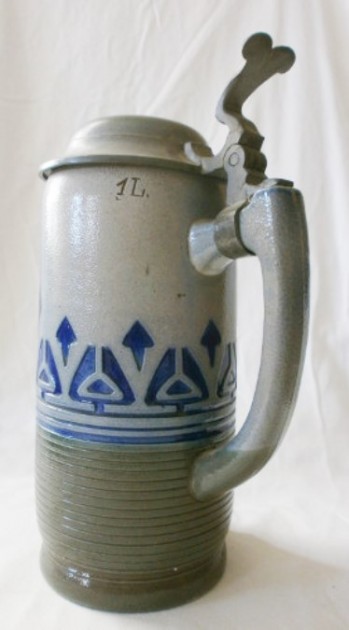 MAUDER, BRUNO – A well known German Jugendstil beer stein designer [PJ]
MAUDER, BRUNO – A well known German Jugendstil beer stein designer [PJ]
“Maundy Thursday” Beaker – Shown ▲: A presentation pewter beaker from the Emperor / Queen of Austria, given to the 12 oldest men and women in the City of Vienna on the Thursday before Good Friday. This was after he she washed their feet, symbolic of Jesus washing the feet of his disciples. These beakers are engraved with the royal Austrian arms and the year of the presentation. He / She also gave the old women 24 gold coins and the men 12 (I guess because they weren’t going to live as long = ?) This custom started with Maria Theresa so there are a few, but not many still left out there.[FWTD] Also see: http://www.steveonsteins.com/two-european-imperial-beakers-11-1-x
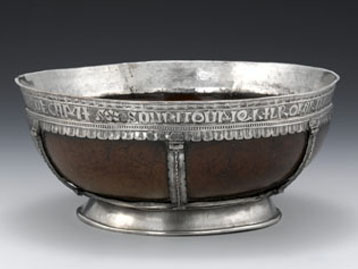
Mazer – A Scottish drinking bowl most made out of very hard maple wood, the older ones usually silver mounted around the lip; comes with a raised center called a “Boss”, which sometimes shows an armorial. Shown: A silver mounted Mazer called the Bute mazer, in the Museum of Scotland. 10 inches in diameter. Circa 1320! (They say!)

This is a design for a tee shirt ~ now discontinued I believe. It was offered a few years back from “The Viking Lady.” Great for a “Drinking Horn” collector. 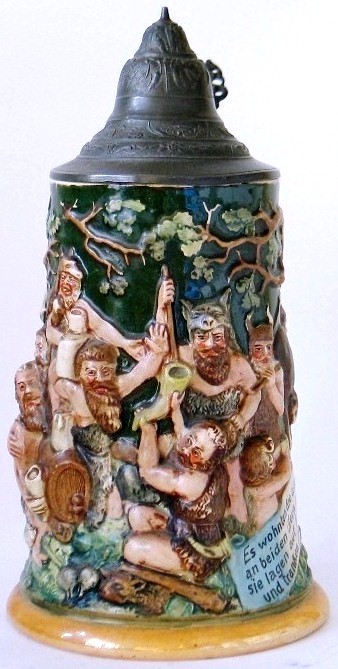 Mead – The name of an mildly alcoholic drink made by the fermentation of honey mixed with water. Alcoholic drinks made from honey were common in ancient times, and during the middle ages throughout Europe, and especially Scandinavia. Most monasteries throughout Europe made mead and sold their excess to the general population. Shown: A half liter relief stein by Hanke, showing the old Germans (not Vikings) enjoying their mead. See: http://www.steveonsteins.com/hermanns-story .
Mead – The name of an mildly alcoholic drink made by the fermentation of honey mixed with water. Alcoholic drinks made from honey were common in ancient times, and during the middle ages throughout Europe, and especially Scandinavia. Most monasteries throughout Europe made mead and sold their excess to the general population. Shown: A half liter relief stein by Hanke, showing the old Germans (not Vikings) enjoying their mead. See: http://www.steveonsteins.com/hermanns-story .
Measure – A utensil that has been around about as long as someone had excess water, other liquids, or food, and wanted to sell it. Most every European country had them in place and under standardization by the 1800’s, Russia being the largest exception. ▲Shown above: A massive and heavy USA gallon measure, made of copper and brass for use in the State of Ohio, and so marked; perhaps used for quality control in the breweries. Stamped inspection marks indicate it is circa 1935, sometime after ‘Prohibition’ was repealed. [FWTD] (It make a great spare toilet paper holder!)
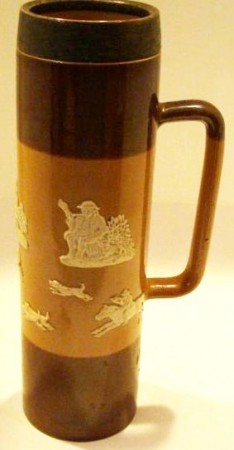
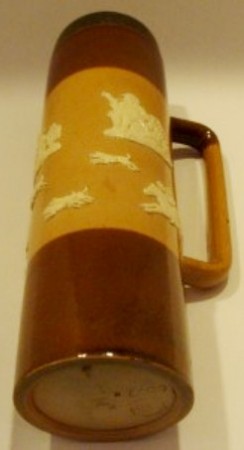
Shown: A Doulton Lambeth (personal use measure of English stoneware 7 1/2″ tall and 2″ in diameter at the top. Silver lip. Circa 1891-1902.
Meerschaum Steins and Tankards – A mineral, hydrous magnesium silicate, occurring in white, clay like masses, used for ornamental carvings, for pipe bowls, etc.; (Sepiolite.) This stein example shown ▲with gold plated mounts was made (as were many) by Elkington and Co., Birmingham, England. Circa 1880. I believe the finial is of silver and that dark because no one took the time to shine it for years.
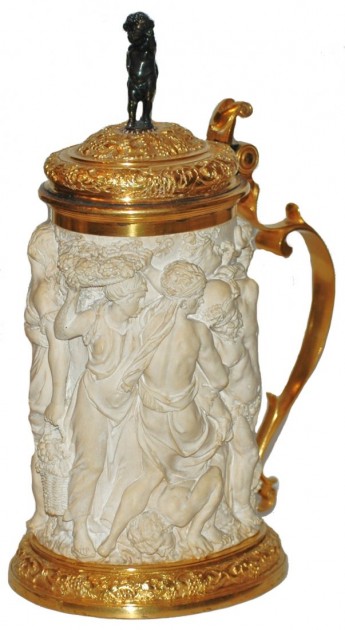
Meigh, Charles, (maker) – Gothic English Stoneware Apostles Jug. The firm made many pitchers in this style body.
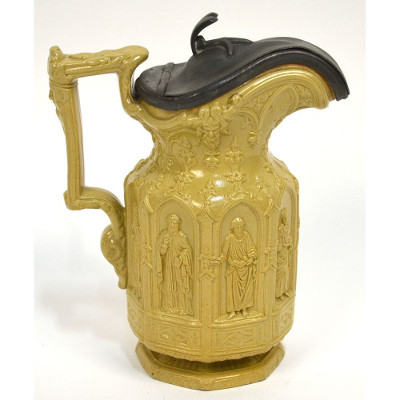
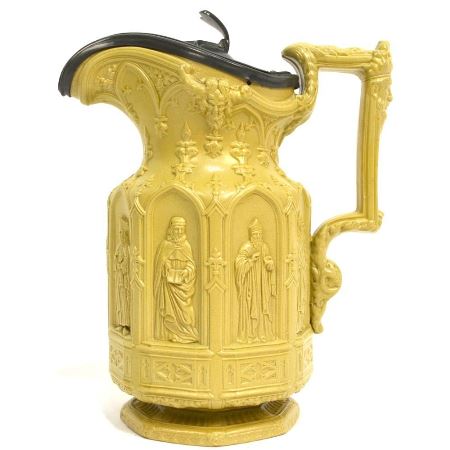
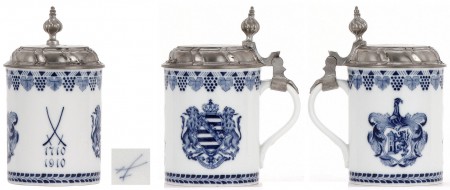 Meissen, “The cradle of Saxony.” – An old medieval city in Saxony, Germany, world famous for its porcelain wares! Meissen porcelain, the first European “hard-paste” porcelain, was developed in 1708 . It was Johann Friedrich Böttger who brought porcelain to the market, and he has often been credited with the invention. The production of porcelain at Meissen, near Dresden, started in 1710 and attracted artists and artisans to establish one of the most famous porcelain manufacturers, still in business today as Staatliche Porzellan-Manufaktur Meissen GmbH. Its signature logo, the crossed swords, was introduced in 1720 to protect its production; the mark of the crossed swords is one of the oldest trademarks in existence. It dominated the style of European porcelain until 1756. [tasco]
Meissen, “The cradle of Saxony.” – An old medieval city in Saxony, Germany, world famous for its porcelain wares! Meissen porcelain, the first European “hard-paste” porcelain, was developed in 1708 . It was Johann Friedrich Böttger who brought porcelain to the market, and he has often been credited with the invention. The production of porcelain at Meissen, near Dresden, started in 1710 and attracted artists and artisans to establish one of the most famous porcelain manufacturers, still in business today as Staatliche Porzellan-Manufaktur Meissen GmbH. Its signature logo, the crossed swords, was introduced in 1720 to protect its production; the mark of the crossed swords is one of the oldest trademarks in existence. It dominated the style of European porcelain until 1756. [tasco] 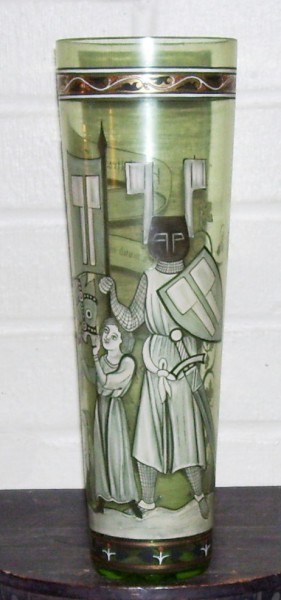 Meistersingers – The Meistersingers carried on and developed from the traditions of the medieval Minnesingers. They belonged to the artisan and trading classes of the German towns, and regarded as their masters and the founders of their guild twelve poets of the Middle High German period, including Wolfram von Eschenbach, Konrad von Würzburg, Reinmar von Zweter, and Heinrich Frauenlob. Frauenlob is said to have established the earliest Meistersinger school at Mainz, early in the 14th century. The schools were established first in the upper Rhine district, then elsewhere. In the 14th century there were schools at Mainz, Strasbourg, Frankfurt, Würzburg, Zurich, and Prague; in the 15th at Augsburg and Nuremberg. Nuremberg, under the leadership of Hans Sachs, became the most famous school in the 16th century, by which time Meistersinger schools had spread all over Germany and farther north, to Magdeburg, Breslau Görlitz, and Danzig. Each guild had various classes of members, ranging from beginners, or Schüler (corresponding to trade apprentices), and Schulfreunde (who were equivalent to Gesellen or journeymen), to Meister. Meisters were poets who could both write new verses to existing melodies and invent new melodies. The poem was technically known as a Bar or Gesetz, the melody as a Ton or Weis. The songs were all sung without accompaniment. [Sourse: http://en.wikipedia.org/wiki/Meistersinger] Shown: Enameled 12 inch tall beaker with scene of ‘Wolfram von Eschenbach’ and his knightly page, one of the most famous Meistersingers. Unknown Glass maker. [FWTD] See full length article with more photos: http://www.steveonsteins.com/the-funnel-man-and-its-relationship-to-the-the-minnesingers-and-the-meistersingers
Meistersingers – The Meistersingers carried on and developed from the traditions of the medieval Minnesingers. They belonged to the artisan and trading classes of the German towns, and regarded as their masters and the founders of their guild twelve poets of the Middle High German period, including Wolfram von Eschenbach, Konrad von Würzburg, Reinmar von Zweter, and Heinrich Frauenlob. Frauenlob is said to have established the earliest Meistersinger school at Mainz, early in the 14th century. The schools were established first in the upper Rhine district, then elsewhere. In the 14th century there were schools at Mainz, Strasbourg, Frankfurt, Würzburg, Zurich, and Prague; in the 15th at Augsburg and Nuremberg. Nuremberg, under the leadership of Hans Sachs, became the most famous school in the 16th century, by which time Meistersinger schools had spread all over Germany and farther north, to Magdeburg, Breslau Görlitz, and Danzig. Each guild had various classes of members, ranging from beginners, or Schüler (corresponding to trade apprentices), and Schulfreunde (who were equivalent to Gesellen or journeymen), to Meister. Meisters were poets who could both write new verses to existing melodies and invent new melodies. The poem was technically known as a Bar or Gesetz, the melody as a Ton or Weis. The songs were all sung without accompaniment. [Sourse: http://en.wikipedia.org/wiki/Meistersinger] Shown: Enameled 12 inch tall beaker with scene of ‘Wolfram von Eschenbach’ and his knightly page, one of the most famous Meistersingers. Unknown Glass maker. [FWTD] See full length article with more photos: http://www.steveonsteins.com/the-funnel-man-and-its-relationship-to-the-the-minnesingers-and-the-meistersingers 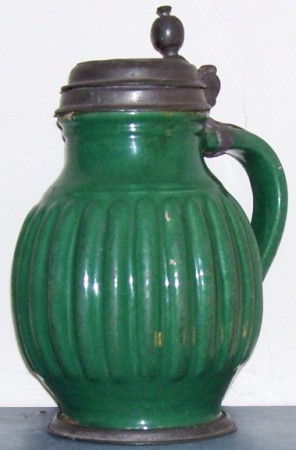 melonenkrug (germ. = Melon jug – 1700’s Stoneware jugs (steins) most made at Bunzlau, Germany that look like some type of melon. The color on this one helps. [JS]
melonenkrug (germ. = Melon jug – 1700’s Stoneware jugs (steins) most made at Bunzlau, Germany that look like some type of melon. The color on this one helps. [JS] 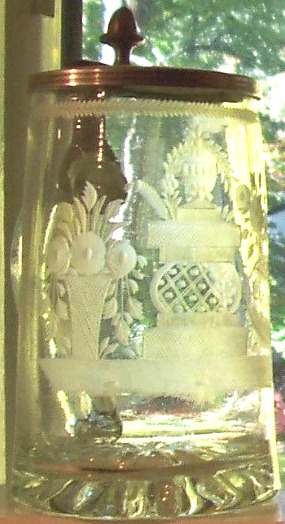
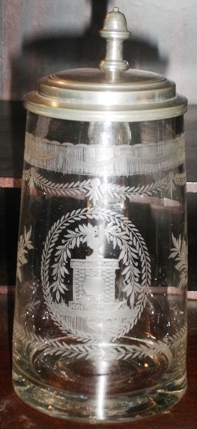 Memorial steins (for death) – German steins which honoring the recent deceased mostly found in clear glass with engraved memorials showing large tomb stones, flowers, angles and sayings. Popular in the time period 1790 to 1850, which is about when the custom seems to have “died out” itself. Nothing has ever been written here in the USA about these unusual steins. Shown above: Two examples of nice engraving work. Shown Below: Detail of a one liter engraved and gold leafed stein saying, “In memory of my father. “
Memorial steins (for death) – German steins which honoring the recent deceased mostly found in clear glass with engraved memorials showing large tomb stones, flowers, angles and sayings. Popular in the time period 1790 to 1850, which is about when the custom seems to have “died out” itself. Nothing has ever been written here in the USA about these unusual steins. Shown above: Two examples of nice engraving work. Shown Below: Detail of a one liter engraved and gold leafed stein saying, “In memory of my father. “ 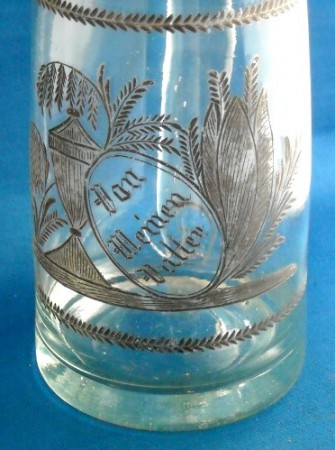 Shown: A one liter with its original gold leaf application still intact for the most part. For more info on Memorial steins, see the page: http://www.steveonsteins.com/german-bohemian-death-memorial-beer-steins-new12-15-11
Shown: A one liter with its original gold leaf application still intact for the most part. For more info on Memorial steins, see the page: http://www.steveonsteins.com/german-bohemian-death-memorial-beer-steins-new12-15-11 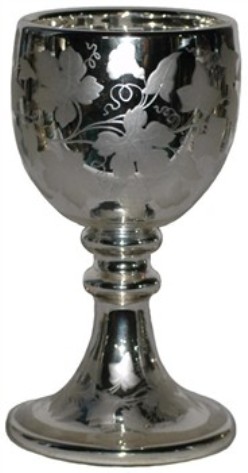 Mercury glass – Very similar to Mars and Venus glass, but closer to the sun!
Mercury glass – Very similar to Mars and Venus glass, but closer to the sun! 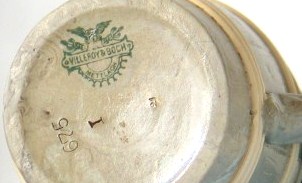 Mercury mark – A green stamp used on some V & B Mettlach wares that has the head of Mercury on it. Using the number of small dots on the banner beneath can determine the year of production (very complicated and many of us don’t really G/A/S, but then again some really do!)
Mercury mark – A green stamp used on some V & B Mettlach wares that has the head of Mercury on it. Using the number of small dots on the banner beneath can determine the year of production (very complicated and many of us don’t really G/A/S, but then again some really do!)
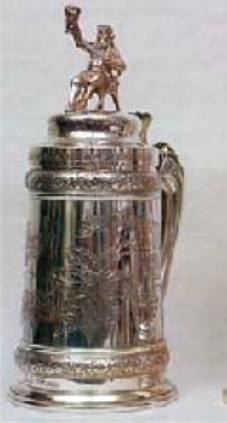 Meriden, Britannia ware – Located in Conn., a large USA Silver plating firm. See: http://www.steinmarks.co.uk/pages/pv.asp?p=stein1
Meriden, Britannia ware – Located in Conn., a large USA Silver plating firm. See: http://www.steinmarks.co.uk/pages/pv.asp?p=stein1 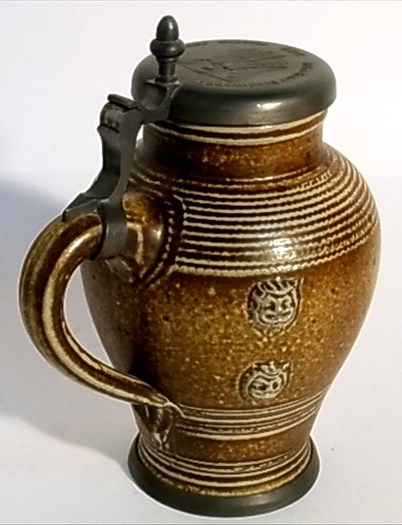
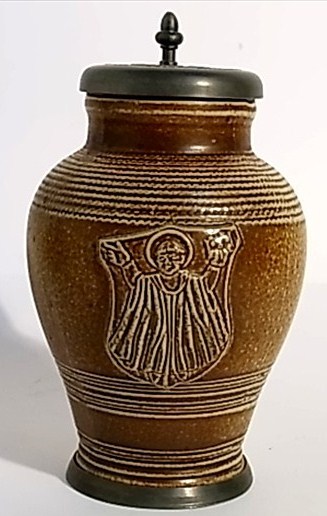
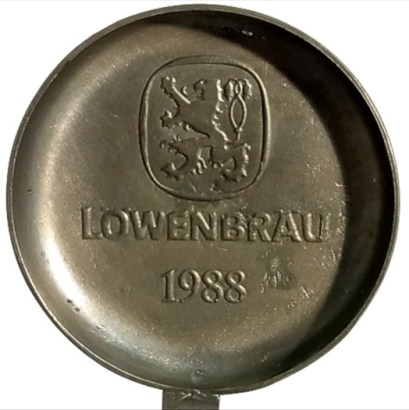
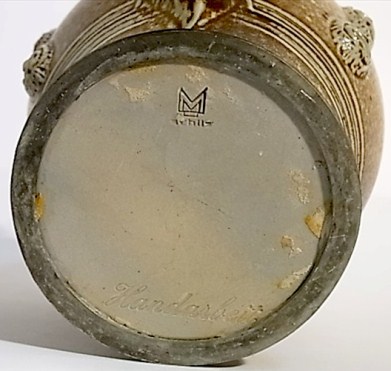 Merkelbach, Karl, III – A modern day stein maker. Part of the well known Merkelbach family of potters in Hohr-Grenzhausen. Shown: A special edition “Tigerware type” stein commissioned by Lowenbrau in 1988. For more on the potter see: http://www.steinmarks.co.uk/pages/pv.asp?p=stein339
Merkelbach, Karl, III – A modern day stein maker. Part of the well known Merkelbach family of potters in Hohr-Grenzhausen. Shown: A special edition “Tigerware type” stein commissioned by Lowenbrau in 1988. For more on the potter see: http://www.steinmarks.co.uk/pages/pv.asp?p=stein339 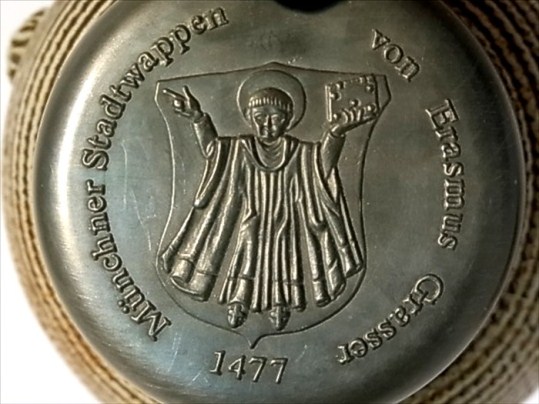
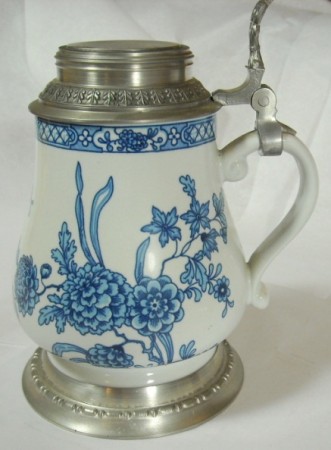 Merkle, Dr. – Firm that hand painted purchased steins from other companies. Shown: Decorated V & B Mettlach stein. See: http://www.steinmarks.co.uk/pages/pv.asp?p=stein1 .
Merkle, Dr. – Firm that hand painted purchased steins from other companies. Shown: Decorated V & B Mettlach stein. See: http://www.steinmarks.co.uk/pages/pv.asp?p=stein1 . 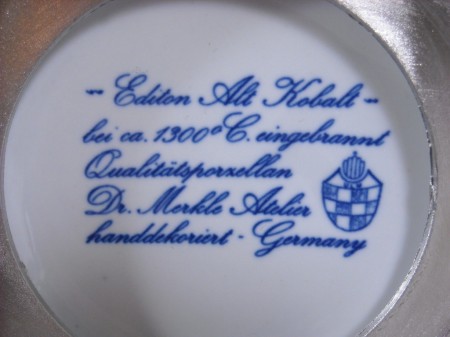
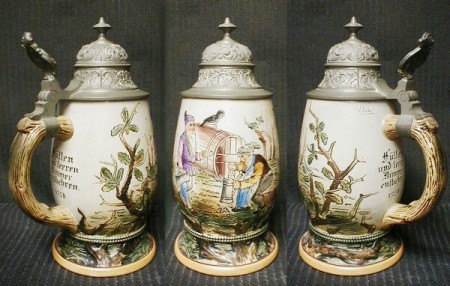 Merkelbach and Wick, Grenslausen. (M W, Gr.[IN A CIRCLE] ) – German pottery stein makers. Very good quality. The firm later became Wick-Werke. Shown: An incised 1/2 liter pottery stein. Circa 1900. See: http://www.steinmarks.co.uk/pages/pv.asp?p=stein1 .
Merkelbach and Wick, Grenslausen. (M W, Gr.[IN A CIRCLE] ) – German pottery stein makers. Very good quality. The firm later became Wick-Werke. Shown: An incised 1/2 liter pottery stein. Circa 1900. See: http://www.steinmarks.co.uk/pages/pv.asp?p=stein1 . ![WHAT THE HELL IS THIS BY WICK-WERKE - MARBLIZED [Q]](http://www.steveonsteins.com/wp-content/uploads/2011/02/WHAT-THE-HELL-IS-THIS-BY-WICK-WERKE-MARBLIZED-Q.jpg) A very unusual 2 liter, Wick-Werke serving stein, with a marbleized body coating. Mettlach – A ‘misnomer’ for items produced by Villeroy and Boch at their plant located at Mettlach, Saar, Germany. Just one of many of their (V & B) factory locations. They made tens of thousands of, I think, now-a-days, very overpriced steins. SCI’s nic-name is “Mettlach Collectors International.” See also “Villeroy and Boch” in this Compendium for more photos. See: http://www.steincollectors.org/library/articles/mettlach/mettlach.htm See: http://www.steinmarks.co.uk/pages/pv.asp?p=stein1 Also see the “You Tube” video made by Roy DeSelms, a SCI Master Steinologist: http://www.youtube.com/watch?v=s09qlDfRG1g
A very unusual 2 liter, Wick-Werke serving stein, with a marbleized body coating. Mettlach – A ‘misnomer’ for items produced by Villeroy and Boch at their plant located at Mettlach, Saar, Germany. Just one of many of their (V & B) factory locations. They made tens of thousands of, I think, now-a-days, very overpriced steins. SCI’s nic-name is “Mettlach Collectors International.” See also “Villeroy and Boch” in this Compendium for more photos. See: http://www.steincollectors.org/library/articles/mettlach/mettlach.htm See: http://www.steinmarks.co.uk/pages/pv.asp?p=stein1 Also see the “You Tube” video made by Roy DeSelms, a SCI Master Steinologist: http://www.youtube.com/watch?v=s09qlDfRG1g 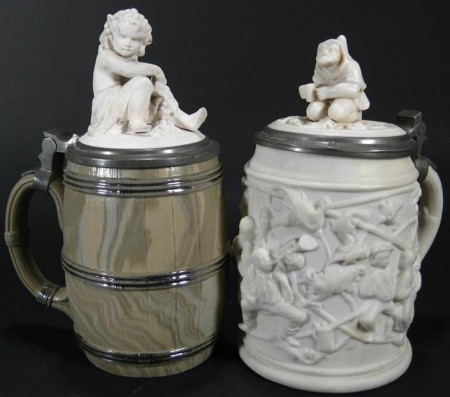 Mettlach, V & B- Early ware [style] steins. ▲ Mettlach, V & B – Mold No. 6 – I normally would not single out one V & B piece / stein over another but I think Number 6 is so very interesting. It appears in so many versions one might be tempted to start a collection of just those. Here are a just a few examples seen recently:
Mettlach, V & B- Early ware [style] steins. ▲ Mettlach, V & B – Mold No. 6 – I normally would not single out one V & B piece / stein over another but I think Number 6 is so very interesting. It appears in so many versions one might be tempted to start a collection of just those. Here are a just a few examples seen recently: 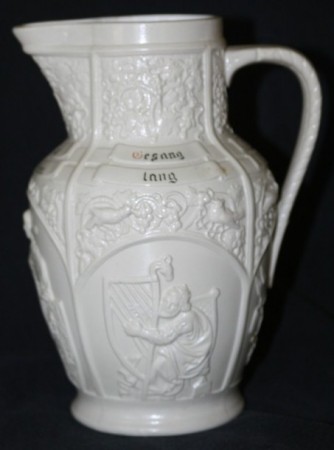
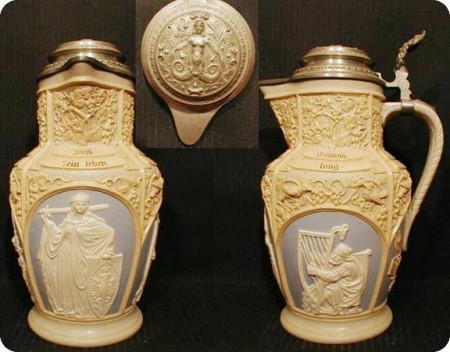 Shown ▲: A V & B Mettlach No. 6 – This design shows King David playing his harp.with the inscription above the scene = “SEGANG LANG” literally means “ Long Song” A better interpretation would be: “Lengthy Melody.” This I think is the version seen most often. (Comps. Stein Center)
Shown ▲: A V & B Mettlach No. 6 – This design shows King David playing his harp.with the inscription above the scene = “SEGANG LANG” literally means “ Long Song” A better interpretation would be: “Lengthy Melody.” This I think is the version seen most often. (Comps. Stein Center) 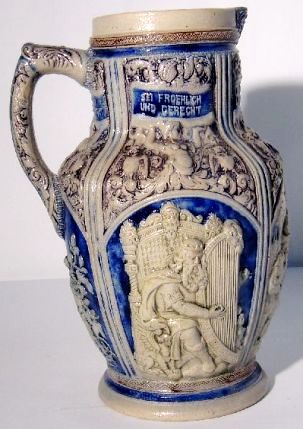 Of course once on design becomes popular = sells well, then other companies notice and produce their own version. Above▲: Another colored version of the No. 6 , David playing his harp, on a Westerwald pottery beer jug, 10.5 inches. Circa 1870. Notice the scene is reversed and a few features were added; same verse however as on the V & B piece ▲. The other two scenes are different however. late 2013 – now you my see a full page article on V & B No. 6: http://www.steveonsteins.com/the-v-b-mettlach-no-6-think-you-have-seen-them-all-new-5-15-13 [END – SP104 – 97- R5]
Of course once on design becomes popular = sells well, then other companies notice and produce their own version. Above▲: Another colored version of the No. 6 , David playing his harp, on a Westerwald pottery beer jug, 10.5 inches. Circa 1870. Notice the scene is reversed and a few features were added; same verse however as on the V & B piece ▲. The other two scenes are different however. late 2013 – now you my see a full page article on V & B No. 6: http://www.steveonsteins.com/the-v-b-mettlach-no-6-think-you-have-seen-them-all-new-5-15-13 [END – SP104 – 97- R5]  “24 hours in a day . 24 beers in a case . coincidence?”
“24 hours in a day . 24 beers in a case . coincidence?”

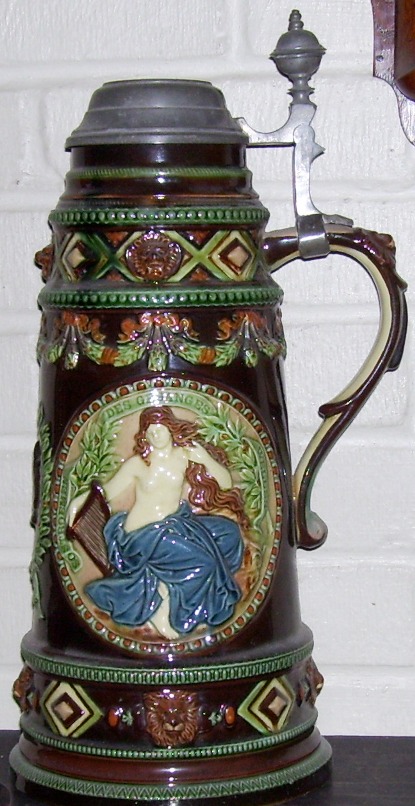
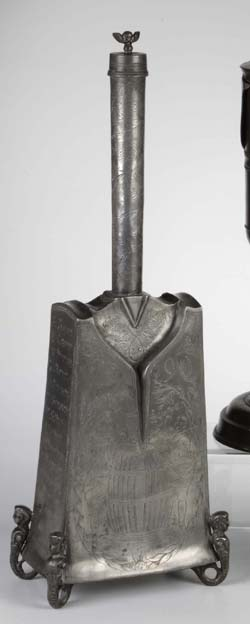
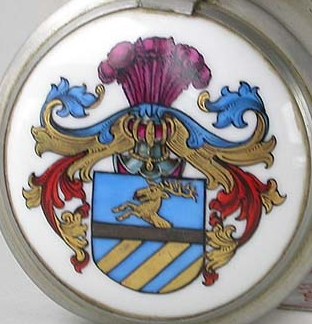
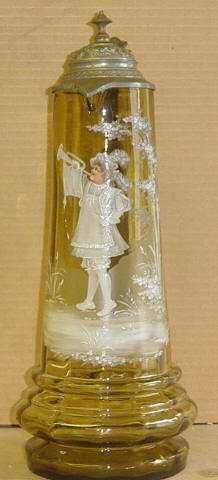
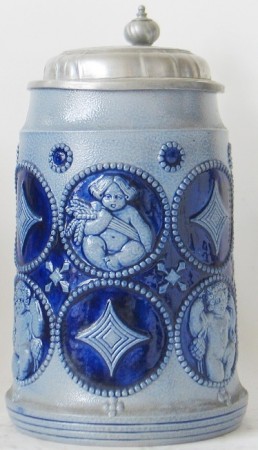
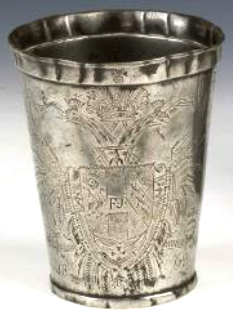
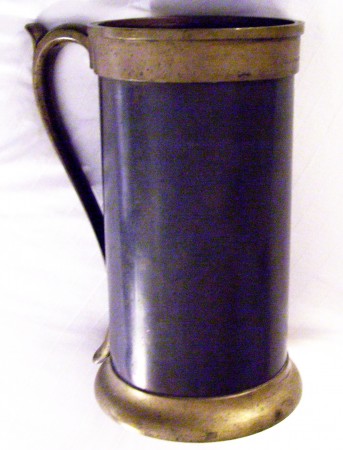
Leave a Reply